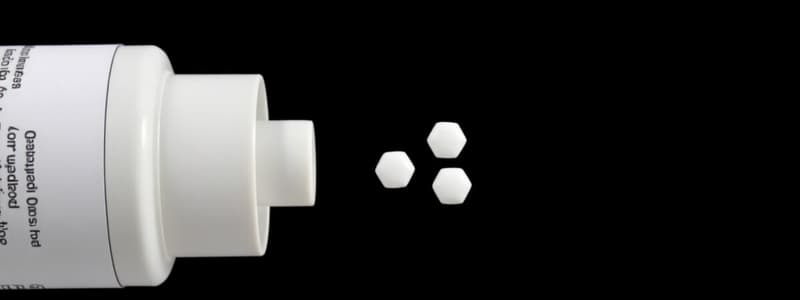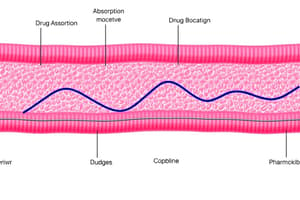Podcast
Questions and Answers
Why might the oral route of administration be inadvisable for some patients?
Why might the oral route of administration be inadvisable for some patients?
- Some patients, like the very young or older adults, may have difficulty swallowing, and it is inadvisable for a patient experiencing nausea and vomiting. (correct)
- It is only suitable for drugs requiring a high first-pass metabolism.
- It completely bypasses liver metabolism, leading to potential toxicity.
- It always leads to a slower onset of action compared to other routes.
Local drug administration offers which of the following advantages?
Local drug administration offers which of the following advantages?
- Reduced risk of systemic side effects due to site-specific application. (correct)
- Ensured high first-pass metabolism for drug activation.
- Exclusive targeting of systemic circulation.
- Guaranteed faster onset of action compared to systemic routes.
How does the first-pass effect influence drug administration?
How does the first-pass effect influence drug administration?
- It may require drugs to be given in larger oral doses or by another route to bypass liver metabolism. (correct)
- It prevents drug accumulation by halting metabolism.
- It ensures that all drugs are fully metabolized before reaching systemic circulation.
- It speeds up drug absorption, leading to a quicker onset of action.
Which of the following is an example of a route of administration that bypasses the first-pass effect?
Which of the following is an example of a route of administration that bypasses the first-pass effect?
What is a characteristic of drugs administered intravenously?
What is a characteristic of drugs administered intravenously?
Factors such as the patient being very young or very old might influence what aspect of route of administration?
Factors such as the patient being very young or very old might influence what aspect of route of administration?
What is the primary difference between local and systemic drug administration?
What is the primary difference between local and systemic drug administration?
How does the form of medication affect the absorption rate?
How does the form of medication affect the absorption rate?
How do transdermal patches administer medication?
How do transdermal patches administer medication?
Which route of administration is most suitable for delivering large quantities of a drug systemically?
Which route of administration is most suitable for delivering large quantities of a drug systemically?
Why are drugs sometimes administered via inhalation?
Why are drugs sometimes administered via inhalation?
What is a key advantage of injecting a drug into a muscle compared to directly into the bloodstream?
What is a key advantage of injecting a drug into a muscle compared to directly into the bloodstream?
Which of the following is considered an enteral route of administration?
Which of the following is considered an enteral route of administration?
What is the primary purpose of administering a drug topically?
What is the primary purpose of administering a drug topically?
Which of the following is a characteristic of the subarachnoid space and intrathecal route?
Which of the following is a characteristic of the subarachnoid space and intrathecal route?
How does liver metabolism affect drug activity?
How does liver metabolism affect drug activity?
How do enteric coatings affect drug release from a tablet?
How do enteric coatings affect drug release from a tablet?
Which factor does NOT directly affect drug absorption?
Which factor does NOT directly affect drug absorption?
What influence does lipophilicity have on membrane permeability of drugs?
What influence does lipophilicity have on membrane permeability of drugs?
Which route of administration typically results in the most rapid onset of action?
Which route of administration typically results in the most rapid onset of action?
What is a key consideration for choosing a route of administration when a patient is taking multiple potent prescription drugs?
What is a key consideration for choosing a route of administration when a patient is taking multiple potent prescription drugs?
What primarily determines the duration of action for a controlled-release tablet compared to an immediate-release tablet of the same drug?
What primarily determines the duration of action for a controlled-release tablet compared to an immediate-release tablet of the same drug?
Which of the following factors contributes to a drug having a low bioavailability after oral administration?
Which of the following factors contributes to a drug having a low bioavailability after oral administration?
What is the purpose of including additives like disintegrants in tablet formulations?
What is the purpose of including additives like disintegrants in tablet formulations?
Which route of administration is most likely to cause immediate systemic effects?
Which route of administration is most likely to cause immediate systemic effects?
Why might a doctor choose a route of administration other than oral or parateral?
Why might a doctor choose a route of administration other than oral or parateral?
How does ionization affect membrane permeability?
How does ionization affect membrane permeability?
How does a tablet being lypholized affect its ability to dissolve?
How does a tablet being lypholized affect its ability to dissolve?
When would you use intravenous methods?
When would you use intravenous methods?
What is the role of binders?
What is the role of binders?
What is a disadvantage of taking an oral medication?
What is a disadvantage of taking an oral medication?
What determines the surface area for drug absorption?
What determines the surface area for drug absorption?
What happens if the liver or kidney do not function?
What happens if the liver or kidney do not function?
Which of the following is an advantage of oral administration of drugs?
Which of the following is an advantage of oral administration of drugs?
Flashcards
Route of Administration (ROA)
Route of Administration (ROA)
The method of administering a drug into the body.
Ease of Administration
Ease of Administration
The ease with which a route can be used by the patient, affecting choice of ROA.
Local Drug Use
Local Drug Use
Administering drugs for site-specific applications, such as eye drops or local anesthetics.
Systemic Drug Use
Systemic Drug Use
Signup and view all the flashcards
Onset of Action
Onset of Action
Signup and view all the flashcards
Duration of Action
Duration of Action
Signup and view all the flashcards
Quantity of Drug
Quantity of Drug
Signup and view all the flashcards
First-pass effect
First-pass effect
Signup and view all the flashcards
Oral Route
Oral Route
Signup and view all the flashcards
Parenteral Route
Parenteral Route
Signup and view all the flashcards
Topical Route
Topical Route
Signup and view all the flashcards
Rectal Route
Rectal Route
Signup and view all the flashcards
Inhalation Route
Inhalation Route
Signup and view all the flashcards
Intradermal Route
Intradermal Route
Signup and view all the flashcards
Subcutaneous route
Subcutaneous route
Signup and view all the flashcards
Intramuscular Route (IM)
Intramuscular Route (IM)
Signup and view all the flashcards
Intravenous Route (IV)
Intravenous Route (IV)
Signup and view all the flashcards
Intrathecal Route
Intrathecal Route
Signup and view all the flashcards
Intra-articular route
Intra-articular route
Signup and view all the flashcards
Bioavailability
Bioavailability
Signup and view all the flashcards
Bioequivalence
Bioequivalence
Signup and view all the flashcards
Speed of Drug Onset
Speed of Drug Onset
Signup and view all the flashcards
Dosing Interval
Dosing Interval
Signup and view all the flashcards
Drug Absorption
Drug Absorption
Signup and view all the flashcards
Rate of drug release
Rate of drug release
Signup and view all the flashcards
Membrane Permeability
Membrane Permeability
Signup and view all the flashcards
Surface Area
Surface Area
Signup and view all the flashcards
Dosage Form
Dosage Form
Signup and view all the flashcards
Excipients
Excipients
Signup and view all the flashcards
Manufacturing Parameters
Manufacturing Parameters
Signup and view all the flashcards
Enteric Coating
Enteric Coating
Signup and view all the flashcards
Reservoir Diffusion
Reservoir Diffusion
Signup and view all the flashcards
Matrix Diffusion
Matrix Diffusion
Signup and view all the flashcards
Lipophilicity
Lipophilicity
Signup and view all the flashcards
Ionization
Ionization
Signup and view all the flashcards
Study Notes
- Route of administration (ROA) refers to how a drug gets onto or into the body
- Drugs/API (as drug products) come in many different forms designed by pharmaceutical scientists for administration or application.
- Many factors determine the choice of ROA such as: ease of administration, site and onset of action, duration of action, quantity of drug, and metabolism by the liver or excretion by the kidney.
Ease of Administration
- Prescribers assess characteristics to determine ROA.
- Difficulty swallowing may make oral administration inadvisable for older or very young patients
- Oral administration is inadvisable for patients experiencing nausea and vomiting.
Site of Action
- The choice of ROA is influenced by the desired site of action
- Local use refers to site-specific applications of drugs for the eye, ear, and local anesthesia for gums treatment.
- Systemic use refers to the absorption of a drug into the blood
- Drugs meant for systemic administration may target a specific site of action
- Trastuzumab targets HER-2 (human epidermal growth factor receptor 2) for cancer
Onset of Action
- Onset rate varies with ROA
- Oral medications for systemic use must proceed through a series of steps before they exert their therapeutic effect
- Liquid solutions or suspensions work faster than oral tablets or capsules because they are more readily available for absorption
- Tablets placed under the tongue or between the cheek and gums work quickly because the medication bypasses the stomach and liver, going directly into the bloodstream
- Drugs injected/infused directly into the bloodstream are carried immediately throughout the body
- Onset action of IV injections is seconds
- Onset action of IM and SC injections, Buccal, and Aerosols is minutes
- Onset action of injections, solutions, Suspensions, Powders, Capsules, Granules, Tablets, and Modified release is minutes to hours
- Onset action of Enteric coated Formulations is several hours
- Onset action of Depot injections and implants is days to weeks
- Onset action of Topical Preparations varies
Duration of Action
- Is how long a drug gives the desired response or is at the therapeutic level
- Controlled extended-release tablets may last for 12 to 24 hours, compared with 4 to 6 hours for the same drug in an immediate-release formulation
- Transdermal patches deliver small amounts of a drug steadily over many hours or even days
- Injections into the muscle and skin last longer than injections directly into the bloodstream
Quantity of Drug
- ROA depends on the drug amount
- A capsule filled with a lot of filler (diluent) might be preferred for a drug containing a very small amount of active ingredient.
- IV infusion is an excellent method for the systemic delivery of large quantities of material.
Metabolism by the Liver or Excretion by the Kidney
- Liver metabolism breaks down an active drug to inactive metabolites for elimination and to prevent drug accumulation
- The first-pass effect is the extent to which a drug is metabolized by the liver before reaching systemic circulation
- This influences the activity of several drugs, and such drugs are given in large oral doses or by another ROA to bypass or overcome metabolism by the liver.
- Age-related or disease-related changes in liver or kidney function can cause drug accumulation or toxicity
- Drug-drug interactions, drug accumulation, and increased toxic blood levels are risks if a patient is on multiple potent prescription drugs
Classifications of Routes of Administration
- Systemic: the drug enters blood and produces systemic effects
- Enteral
- Oral
- Sublingual
- Rectal
- Parenteral
- Inhalational
- Injections
- Transdermal
- Intravenous
- Intramuscular
- Subcutaneous
- Intra-arterial
- Intra-articular
- Intrathecal
- Intradermal
- Enteral
- Local:
- Skin topical
- Intranasal
- Ocular drops
- Mucosal-throat, vagina, mouth, ear
- Inhalational
- Transdermal
Local ROA
- Administration of a drug at the site where the desired action is required
- Topical: Drug is applied to the skin or mucous membrane at various sites.
- Skin: Ointment, cream, lotion, or powder
- Example: clotrimazole (antifungal) for cutaneous candidiasis
- Eye, ear, and nose: Drops, ointments, and sprays
- Example: gentamicin eye/ear drops
- Oral cavity: As a gel
- Example: 2% lidocaine (for topical anesthesia)
- Rectum
- Enema: Drug administration into the rectum involves a liquid
- Soap water enema acts as a lubricant, and water stimulates the rectum
- Suppository: Drug administration into the rectum involves a solid
- Bisacodyl causes bowel evacuation
- Enema: Drug administration into the rectum involves a liquid
- Bronchi: As inhalation examples are salbutamol, ipratropium bromide, etc. for bronchial asthma and chronic obstructive pulmonary disease (COPD).
- Skin: Ointment, cream, lotion, or powder
Systemic ROA
- Drugs administered by this route enter blood and produce systemic effects
- Enteral routes are oral, sublingual, and rectal
- Oral: Dosage forms are tablet, capsule, and syrup, etc
- Example: paracetamol tablet for fever and omeprazole capsule for peptic ulcer
- Sublingual: Preparation is kept under the tongue
- The drug is absorbed through the buccal mucous membrane and enters systemic circulation directly
- Example: nitroglycerin for acute anginal attack
- Oral: Dosage forms are tablet, capsule, and syrup, etc
- Rectal: Drug can be given in solid or liquid form
- Suppository: Can be used for local (topical) and also systemic effects
- Example: indomethacin for rheumatoid arthritis and diazepam for status epilepticus
- Inhalation: Volatile liquids and gases are given by inhalation for systemic effects; example: general anesthetics
- Transdermal: Drug is administered as a patch or ointment; it delivers the drug into circulation for systemic effect
- Used for angina, contraception, hormone replacement, and analgesia
- Suppository: Can be used for local (topical) and also systemic effects
- Systemic Parenteral Routes are routes of administration other than enteral
- Intradermal: Drug is injected into the layers of the skin
- Example: BCG
- Subcutaneous (s.c./SubQ): Drug is injected under the skin in the thigh, abdomen, and arm
- Example: insulin
- Intramuscular (i.m.): Drugs are injected into large muscles such as the deltoid, gluteus maximus, and vastus lateralis
- Example: diclofenac
- Intravenous (i.v.): Drugs are injected directly into the bloodstream through a vein
- Example: antibiotics and antifungals
- Intrathecal: Drug is injected into the subarachnoid space
- Example: spinal anesthetics and morphine
- Intra-articular: Drug is injected directly into the joint space
- Example: hydrocortisone injection for rheumatoid arthritis
- Intradermal: Drug is injected into the layers of the skin
Why Consider How Drugs Get Into Body?
- This is important because it affects
- Bioavailability, or the percentage of the dose that gets into the body
- Bioequivalence, or the similarity between two formulations of the same drug
- Speed of drug onset, or how long it takes a drug to begin working
- Dosing interval, or how often the drug should be given
- Site of action of whether the drug stays local or acts systemically
- Drugs must be absorbed unless injected directly into the bloodstream.
Drug Absorption
- Is the movement of drug molecules across biological barriers (mostly layers of cells) from the site of administration to the bloodstream.
- The rate of drug absorption is affected by:
- Rate of release of drug from pharmaceutical preparation
- Membrane permeability of the drug
- Surface area in contact with the drug
- Blood flow to the site of absorption
What Determines Rate of Release of Drug From Pharmaceutical Preparation
- Dosage Form
- Solution: No Delay, Immediate Release
- Capsules and Tablets: Delay (Dissolution), Followed by Rapid Release
- Creams, Ointments, and Suppositories: No Delay, but Slow Release
- Additives (Excipients)
- Decrease Rate of Dissolution
- Binders
- Coating agents
- Increase Rate of Dissolution
- Disintegrants
- Variable Effects on Rate of Dissolution
- Diluents
- Coloring agents
- Flavoring Agents
- Decrease Rate of Dissolution
- Manufacturing Parameters - Tablet Compression: Hard tablets dissolve very slowly - Lyophilized Tablets: Porous and dissolve rapidly
- Delayed Release Preparations dissolve in the intestines, not in the stomach due to an enteric coating
- Sustained Release Preparations
- Reservoir Diffusion Products: Drugs diffuse from the pill core through the membrane shell
- Matrix Diffusion Products: Drugs diffuse through the matrix in which they are embedded
Factors the Determine Membrane Permeability of Drugs
- Lipophilicity increases membrane permeability
- Presence of Aliphatic and Aromatic Structures
- Absence of Polar Groups
- Ionization decreases membrane permeability
- Weak acids in the intestines are mostly ionized at pH ranges from 6.6-7.5
- Weak bases in the stomach are mostly ionized at pH ranges from 1-2
Factors that Determine Surface Area for Absorption
- Anatomy:
- Low surface area: nasal cavity, buccal cavity, rectum
- High surface area: small intestines and lungs
Oral Administration
- High Safety
- Interactions with food are at risk
- High Commercial Availability of Dosage Forms
- High cost
- Bioavailability is highly and reliably variable
- Onset of action is delayed
- Patient compliance is high
IV Administration
- Low Safety
- Interactions with food are not at risk
- Low Commercial Availability of Dosage Forms
- High Cost
- High and Reliable bioavailability
- Immediate Onset of Action
- Low Patient Compliance
SC Administration
- Oral > SC > IM > IV on Safety
- Oral > IV = IM = SC Interactions with food are at risk
- Oral > IM = SC = IV Commercial Availability of Dosage Forms
- IV > IM > SC > ORAL Cost
- IV > IM = SC > ORAL Bioavailability
- IV > IM > SC > Oral Onset of Action
- IV > IM > SC > Oral Patient Compliance
Why Consider Other Routes of Administration?
- Other than Oral and Parenteral
Studying That Suits You
Use AI to generate personalized quizzes and flashcards to suit your learning preferences.



